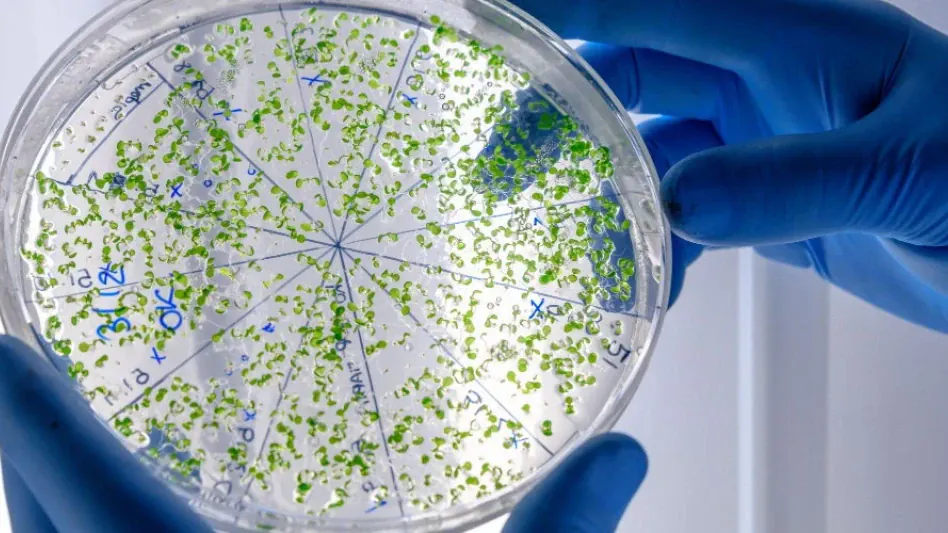Recent advancements in the world of agricultural biotechnology have taken another leap forward with the development of a groundbreaking method for producing a special class of plant hormones called strigolactones. Researchers co-led by the University of California San Diego have pioneered the use of microbial cell factories to synthesize these crucial but understudied plant molecules. With the potential to significantly advance our understanding of strigolactones, this innovative technique promises to transform sustainable agricultural practices. The findings were published on January 17 in the journal Science, detailing how this approach overcomes the limitations previously hampering strigolactone research.
Strigolactones hold a pivotal place in the plant kingdom, playing multiple roles in regulating plant development, managing symbiotic relationships in the soil, and prompting the germination of parasitic plants. Despite their broad importance, scientific exploration of these hormones has been constrained by their natural scarcity in plants, making extraction and study labor-intensive. However, the new method developed by researchers at the UC San Diego Jacobs School of Engineering, in collaboration with UC Riverside and Utsunomiya University in Japan, represents a significant leap forward in overcoming these challenges.
The Role and Importance of Strigolactones
Multifaceted Functions in Plant Development
Strigolactones are indispensable for plant health, functioning as key regulators in diverse developmental processes. These hormones play critical roles in shoot branching, root growth, and leaf senescence. This means they directly influence a plant’s overall productivity and vitality. Furthermore, strigolactones are crucial in establishing symbiotic relationships between plants and soil microbes, facilitating nutrient uptake which is essential for soil health. In particular, they help establish mycorrhizal associations, where fungi colonize plant roots to enhance water and nutrient absorption.
Moreover, strigolactones are involved in intricate signaling that modulates the plant’s response to its environment. They can inhibit shoot branching in response to nutrient scarcity, ensuring that the plant maximizes its limited resources. This hormonal regulation underscores their importance in adaptive plant behaviors, impacting phenotypic plasticity and resilience. As a consequence, deeper insights into their mechanisms could pave the way for innovations that enhance crop performance and sustainability.
Challenges in Studying Strigolactones
Despite the undeniable significance of strigolactones, research has been hindered by their extremely low natural abundance in plants. Extracting these hormones using traditional methods is both labor-intensive and inefficient, requiring substantial volumes of plant material. Typically, this involves collecting xylem sap from numerous trees or similar resource-heavy processes. As a result, the scarce availability of strigolactones has restricted the scientific community’s ability to thoroughly investigate their synthesis pathways and broader biological roles.
The challenge has been compounded by the complexity of different strigolactone molecules. Although about 30 distinct strigolactones have been identified, understanding their specific functions and synthesis routes remains incomplete. This limitation has considerably slowed down the pace at which strigolactone biology can contribute to practical agricultural applications. Therefore, overcoming this scarcity is crucial for expanding knowledge and harnessing these hormones’ full potential in improving agricultural practices.
Breakthrough in Strigolactone Production
Development of Microbial Cell Factories
The central innovation presented in the study lies in the use of microbial cell factories, utilizing E. coli and Baker’s yeast to amplify strigolactone production to previously unattainable levels. Engineered to bypass the bottlenecks of traditional extraction methods, these microbial consortia allow researchers to produce strigolactones at quantities 125 times higher than earlier techniques. This impressive increase obviates the need for vast amounts of plant material, thereby making the process more efficient and sustainable.
The research team centered their efforts on a specific protein-coding gene (CPY722C) found in most flowering plants, which is crucial for converting precursor molecules into various strigolactones. Their hypothesis postulated that related genes (CYP722A and CYP722B) present in numerous seed plants might also be integral to producing vital strigolactones. By testing this theory, they employed a microbial cell factory setup where co-cultured E. coli and Baker’s yeast were used to express these genes from 16 different plant species, including poplar, pepper, pea, and peach.
Methodology and Optimization
Through meticulous metabolic engineering, the research team successfully optimized the microbial cell factories to achieve unprecedented strigolactone output concentrations. This optimization process involved fine-tuning various parameters such as gene expression levels, fermentation conditions, and metabolic pathway regulation to maximize yield. The result was an over 125-fold increase in the production of strigolactones, far surpassing previous capabilities.
The ability to produce these hormones in such significant quantities allowed for more detailed structural and functional analyses than ever before. One notable discovery was the identification and structural determination of a novel strigolactone compound: 16-hydroxy-carlactonic acid (16-OH-CLA). Produced by the action of CYP722A and CYP722B, this compound had been previously reported but its precise structure and significance were not fully understood until the development of the microbial cell factory enabled its abundant production.
Discoveries and Implications
Identification of Novel Strigolactone Compounds
The optimized microbial cell factories revealed exciting new data, including the identification of 16-hydroxy-carlactonic acid (16-OH-CLA). This novel compound, produced by CYP722A and CYP722B, had been documented in earlier reports but lacked detailed structural analysis due to insufficient quantities for study. With the microbial cell factory’s capacity to yield significant amounts, researchers could finally elucidate its structure and investigate its potential biological roles comprehensively.
Investigations revealed that 16-OH-CLA is uniquely present only in the shoots of plants, contrasting with other known strigolactones that are typically found throughout plant tissues, including the roots. Additionally, this compound’s presence is temporal; it diminishes as annual plants like pepper and pea reach maturity and exhibits a seasonal pattern in trees like poplar. These distinctive distribution patterns suggest a role that is likely critical but not yet fully appreciated in plant biology.
Significance of 16-OH-CLA
The distinct presence and distribution of 16-OH-CLA indicate that this compound might play a pivotal role in plant signaling or adaptation to environmental stresses. Unlike other strigolactones, which have been extensively studied in various contexts, 16-OH-CLA’s unique behavior in plants highlights a potentially critical function that has been underexplored. This could involve specific signaling pathways that are active only during certain developmental stages or in response to particular environmental cues.
The newfound ability to produce and study 16-OH-CLA opens up exciting possibilities for further research. Understanding its role could lead to advancements in agricultural technology, such as developing new strategies for enhancing plant resilience to stress or optimizing growth patterns. The discovery underscores the importance of high-yield strigolactone production methods, which enable detailed investigations that were previously not feasible due to the hormones’ scarcity.
Potential Impact on Sustainable Agriculture
Enhancing Plant Health and Productivity
The potential implications of this study for sustainable agriculture are profound. By gaining a deeper understanding of strigolactone synthesis and function, scientists can devise methods to manipulate these hormones to improve plant health and productivity. For instance, optimized strigolactone levels could enhance plant-microbe interactions, leading to healthier soils and more robust nutrient uptake. Additionally, controlling strigolactone signals may help manage parasitic plant invasions, which are significant agricultural pests.
Furthermore, the insights gained from this research could lead to the development of crops that are more resilient to environmental stresses, such as drought or nutrient deficiency. By fine-tuning strigolactone pathways, it might be possible to engineer plants that thrive under adverse conditions, thus improving agricultural yields and sustainability. These advancements could play a crucial role in addressing global food security challenges as the demand for high-yield and resource-efficient crops grows.









